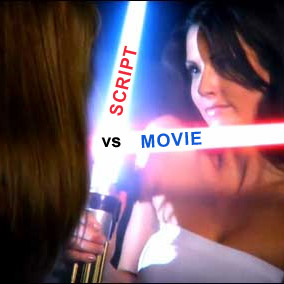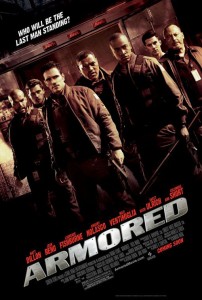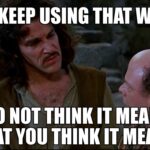 This is the first in what may become a series of articles where I’ll take a look at an early version of a script and compare it to the resulting movie.
This is the first in what may become a series of articles where I’ll take a look at an early version of a script and compare it to the resulting movie.
SPOILER ALERT! SPOILER ALERT! SPOILER ALERT! This article discusses everything from plot twists to the ending of the movie.
Today’s Battle: Armored
In the blue corner, the SCRIPT: Written by James V. Simpson (Feb. 5/07 version)
In the red corner, the MOVIE: Directed by Nimród Antal (Released 2009)
Quick Synopsis (courtesy of IMDB)
A newbie guard for an armored truck company is coerced by his veteran coworkers to steal a truck containing $42 million. But a wrinkle in their supposedly foolproof plan divides the group, leading to a potentially deadly resolution.
The Setup
 Script
Script
- The protagonist lives with his wife and his brother.
- The brother is feeling the pressure over losing his house
- The cops who stumble across the armored guards aren’t mentioned until the second act
Movie
- The protagonist doesn’t have a wife. He just lives with his brother.
- The brother is feeling the pressure over losing his house and having child protective services threatening to take Jimmy away.
- There’s only one cop. You get to know him in the first act.
The added element of the wife doesn’t add anything to the script. In fact it’s a character that simply disappears after the first act. Without the wife, it makes Ty’s (the protagonist’s) job of raising his younger brother on his own, much more difficult. Which sets up the reasons he must participate in the heist much more believable.
Having just the one young cop also works well. You have more invested in the character as you get to know him earlier. You also empathize with him because he’s working on his own and still trying to do the right thing.
Edge: MOVIE
Characters
Script
- I had a hard time distinguishing a number of the characters. Both in terms of individual dialogue and character traits. This was especially true for the characters Quinn and Palmer. In fact, there were many scenes where they were almost treated like one character. For example, on page 90 the phrase: “Quinn and Palmer [insert description here]” appears four times.
Movie
- The characters are well distinguished. Quinn is an old codger with an accent. Baines is a hardened gun nut. Palmer is a bit of a religious freak, etc.
Edge: MOVIE
Believability
Script
- One part, especially, left me scratching my head. Ty exits the armored vehicle through a trap door on the roof and then jumps up to a platform. Keep in mind that the bad guys are right behind the truck. There’s even a line: “All they have to do is look up and they’ll see him!” That type of suspense may work when a hero has no other choice, but it seemed really strange that Ty would put himself in that situation.
- Both cops die — which is fine. But the older cop, who survives the longest, dies somewhat suddenly and unbelievably.
Movie
There were so many unbelievable moments in the movie that, quite honestly, ruined it for me. I was eager to read the script after seeing the movie, because all of these things smacked of director or producer tinkering. Boy was I right.
- Wow, where to begin… Ty almost escapes from the warehouse in one of the two armored cars. Cochrane chases him down and then they somehow arrive back at the same location that they left from. This was a surefire sign that they were trying to keep the budget down — but it was completely unbelievable. (In the script, the chase lands everyone in a different location)
- Palmer kills Dobbs with a small knife by stabbing him in the stomach. That only kills people right away in the movies. (In the script, Dobbs gets shot by Cochrane)
- Ty takes great pains to exit the armored car (through the floor — which works better) without being seen, but then when he reaches the trap door in the roof of the warehouse, he lets it slam down, alerting the bad guys. (In the script, Cochrane figures out that Ty’s no longer in the armored truck because he hears Ty’s call over the other dead cop’s radio.)
- When Palmer goes to investigate the sound and finds Ty trying to get a signal on the radio, instead of shooting Ty, he — I’m not kidding here — jumps off the roof and kills himself because he’s now suddenly distraught over killing his friend Dobbs (who he seemed to very easily kill moments before). (In the script, there is an excellent action chase sequence through the warehouse complex on foot with two guys chasing after Ty)
- Ty tells his brother and the shot police officer whom he just rescued to “stay here” while he goes to get the police car. Why the hell would he do that? It was obviously a contrived set up to give Ty a mano y mano moment with the bad guy Cochrane. (In the script, the cop is dead and Ty takes his brother with him)
- There’s a final chase sequence where Cochrane is in an armored car and chasing Ty (who is on foot) down a path. You know those scenes in the cartoons where all the character needs to do to avoid the falling tree is to jump off to the side? Yeah, it was like that. The path was flanked by low cement walls on either side that would make it easy to escape from the truck had Ty simply decided to hop over the wall.
- To make matters worse, when Ty jumps into a pit to avoid the truck, Cochrane drives the truck off the edge into this pit (instead of calmly stopping his truck, pulling out his gun and shooting Ty). (In the script, there’s a hand-to-hand combat fight scene inside one of the armored trucks)
- The cop, who appeared to be on death’s door, is bright eyed and bushy tailed once he gets to the hospital. He’s so alert, he’s even able to sit up and give the police a statement.
Edge: SCRIPT
Action and Plot
Script
- There’s a nice sequence where a couple of the bad guys go after Ty when he escapes out of the top of the armored truck.
- The sequences with the protagonist stuck in the armored car trying to figure out what to do, were quite realistic and comprehensible. Attaching a flare to a fire extinguisher and then using that to light the money on fire was very clever.
- Ty puts a flare inside the money box to superheat it, along with his remaining ammunition and coins, effectively turning it into a bomb. It was easy to understand and worked really well.
- Ty’s brother Jimmy (who’s a street tough 15 year old) fights to escape from one of the bad guys who is sent to apprehend him. He’s then cuffed with tie straps.
Movie
- Only one guy goes after Ty, and as we learned above, commits suicide. (Seriously, WTF!)
- Without any explanation, Ty sneaks out of the bottom of the armored truck (something he did a number of times I might add, without simply looking for a way to escape) then somehow blows up the hidden money with a flare. We never get to learn how he would actually cause the money bags to explode the way they did.
- When the money box explodes, we have no idea how he rigged things up to explode. Sure we saw the flare, but it simply wasn’t comprehensible without knowing about the ammunition that was placed in the box as well.
- We don’t see any fight scene with Jimmy and when he arrives back at the warehouse with the bad guys, he’s not in tie straps. This kid was a delinquent — it seemed too easy for the bad guy to manage him so easily by himself.
Edge: SCRIPT
The Ending
Script
- Ashcroft, the boss at the armored company, turns out to be in on the heist.
- The cop (both cops) die. One cop dies only moments after he was talking coherently and moving around.
- The bad guy doesn’t die, he’s just left handcuffed to the armored car.
- The final scene has Ty and his family moving — I guess he was forced to sell his house after all. Overall, it’s kind of a downer.
Movie
- Ashcroft, is actually a good guy. These days it’s almost a bigger surprise to have a pivotal character actually be what he seems. That was a nice touch.
- The cop survives — which works much better. It leaves the story on an up-ending, and makes the protagonist look more heroic.
- True to Hollywood bad-guy-death form — the bad guy dies by falling into the pit inside his armored truck. (There are typically only two ways that Hollywood movie bad guys die — by falling or by fire. Think about it.)
- In the final scene we learn that Ty will actually qualify for a reward (and therefore save his house and brother).
Edge: MOVIE
And the Winner is…
THE MOVIE!
While the script was definitely more believable, the movie had a stronger set up, more fleshed out characters and a much stronger ending. Ultimately though, the lack of believability of the movie means that the audience (and box office) is the real loser.
As well, there were too many scenes where the protagonist was simply left to wonder, “What should I do?” and wasn’t coming up with any suitable answers. You’re not going to see that in a comparable (and superior) movie in terms of format — Panic Room, with Jodie Foster.
Many of the elements of the script were changed for the better. Unfortunately, many things were also changed for the worse. That may help to explain the abysmal box office gross of the movie ($14,195,000 vs. $20,000,000 budget) according to Box Office Mojo.
Was this article helpful/interesting? Let me know if you’d like to see more Script vs. Movie battles.





Yes, very helpful, interesting, and fun. Would love to see more Script vs. Movie battles. Onwards and upwards…
3 things: first, armored was kickass! totaly awesome. i saw it. 2nd, do you know how quinn dies? i didn’t really pay attention at that part. and 3rd, can you da a SvM for transformers 2? thanks!
Thanks for the feedback guys. Looks like I’ll definitely have to make this a regular feature.
@transformerfan — In the script, Quinn dies the same way as in the movie — he gets blown all to hell when the money box explodes.
You can find Michael Bay’s rejected Transformers 2 script here. 😉 Seriously though, Roberto Orci and Alex Kurtzman were hired guns for Transformers 2, and they had each worked with and had a good working relationship with Michael Bay before, so it’s unlikely their script and vision would have deviated significantly from the final movie.
This was really interesting and helpful! I’ll definitely be reading your other Script vs. Movies. I’m doing an Armored fanfic.
Glad to hear it, Bleu Jay! Thanks for the note.